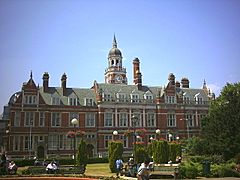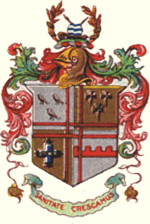County Borough of Croydon facts for kids
| Croydon | |
| Motto: Sanitate Crescimus (May we grow in health) | |
 Croydon Town Hall |
|
| Geography | |
| Status | County borough |
| 1911 area | 9,012 acres (36.5 km2) |
| 1931 area | 12,617 acres (51.1 km2) |
| 1961 area | 12,672 acres (51.3 km2) |
| HQ | Katharine Street, Croydon |
| History | |
| Origin | Parish of Croydon, Surrey |
| Created | 1889 |
| Abolished | 1965 |
| Succeeded by | London Borough of Croydon |
Quick facts for kids Demography |
|
|---|---|
| 1911 population - 1911 density |
169,551 19/acre |
| 1931 population - 1931 density |
233,032 18/acre |
| 1961 population - 1961 density |
252,501 20/acre |
| Politics | |
| Governance | Croydon Corporation |
 Arms of the county borough corporation |
|
Imagine a special area that used to run itself, like a mini-city! That was the County Borough of Croydon. It was a local government area around the town of Croydon in Surrey, England. It existed from 1889 until 1965. After 1965, it became part of the bigger London Borough of Croydon, which is now in Greater London.
Contents
History of Croydon's Local Government
Back in 1849, a group called the 'local board of health' was set up for the area of Croydon. This group helped manage things like public health. Later, in 1883, Croydon officially became a 'municipal borough'. This meant it had its own local council and more power to make decisions.
In 1889, Croydon became an 'autonomous county borough'. This was a big step! It meant Croydon could manage most of its own affairs, almost like a small county, without much control from the larger county of Surrey. The original borough included areas like Norwood, Addiscombe, Norbury, and Shirley.
For many years, the county borough was next to the Croydon Rural District. This rural district was removed in 1915. However, Croydon County Borough didn't manage to take over that area. The only major change to its size happened in 1925 when the area of Addington joined the borough.
The borough also ran its own services. For example, it had its own tram system until 1933. It also had its own fire brigade and ambulance service. These services were later taken over when Croydon became a London Borough.
In 1954, Croydon tried to become a 'city'. At that time, it was the only county borough with more than 200,000 people that wasn't a city. But its request was not approved.
Finally, in 1965, the County Borough of Croydon was officially ended. Its area joined with another district, Coulsdon and Purley Urban District, to create the new London Borough of Croydon. This new borough became part of Greater London.
How Croydon's Council Worked
When Croydon first became a borough, it was divided into six areas called 'wards'. Each ward elected six councillors. These councillors, along with 12 'aldermen' (experienced council members) and a 'mayor', formed the town council.
Over the years, the council grew. In 1905, a new ward was added, and the council got bigger. By 1925, there were even more wards, and the council had 18 aldermen and 54 councillors.
In 1930, the wards were reorganised into 15 areas, each electing three councillors. From then until the county borough ended, the council had a mayor, 15 aldermen, and 45 councillors.
The wards in 1930 included:
- Addington
- Addiscombe
- Bensham Manor
- Broad Green
- Central
- East
- Norbury
- South
- South Norwood
- Thornton Heath
- Upper Norwood
- Waddon
- West Thornton
- Woodside
- Whitehorse Manor
Later, the wards changed a little, with a new Shirley ward being created.
Politics in Croydon
From the very beginning, the Croydon council was mostly controlled by groups linked to the Conservative Party. These groups were sometimes called the Coalition Party or the Ratepayers Association. They worked together to oppose the Labour Party.
Croydon also had its own representatives in the national Parliament. In 1885, the borough became a single parliamentary area. By 1918, it was divided into two areas: North and South. By 1955, there were three parliamentary areas: Croydon North East, North West, and South.
Croydon's Coat of Arms
The County Borough of Croydon had its own special coat of arms, which was given to it in 1886. A coat of arms is like a unique symbol or badge for a town or family.
Many of the symbols on Croydon's shield were connected to the Archbishops of Canterbury. They used to have a palace in Croydon. For example, the three black birds (called choughs) are linked to Thomas Becket and appear on the coat of arms of Canterbury city. The small crosses came from the arms of the Canterbury Diocese.
The special cross with three gold circles was from the arms of Archbishop John Whitgift. The wavy line that looks like a wall in the fourth section of the shield represented the town's government.
Above the shield, on the 'crest', there was a grassy mound and a fountain. These symbols represented the Croydon Bourne, which is a local stream. There were also sprigs of rye-grass, which stood for the irrigation fields nearby. A gold shepherd's crook (crozier) was another symbol for the archbishops. A crossed sword and spear represented the East India Company Military Seminary that was in Addiscombe.
The motto, which was in Latin, said Sanitate Crescamus. This means "May we grow in health".
When the London Borough of Croydon was formed in 1965, some parts of this old coat of arms were used to create the new coat of arms of the London Borough of Croydon.

